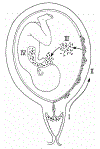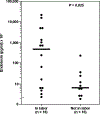The preterm parturition syndrome
- PMID: 17206962
- PMCID: PMC7062298
- DOI: 10.1111/j.1471-0528.2006.01120.x
The preterm parturition syndrome
Erratum in
- BJOG. 2008 Apr;115(5):674-5
Abstract
The implicit paradigm that has governed the study and clinical management of preterm labour is that term and preterm parturition are the same processes, except for the gestational age at which they occur. Indeed, both share a common pathway composed of uterine contractility, cervical dilatation and activation of the membranes/decidua. This review explores the concept that while term labour results from physiological activation of the components of the common pathway, preterm labour arises from pathological signalling and activation of one or more components of the common pathway of parturition. The term "great obstetrical syndromes" has been coined to reframe the concept of obstetrical disease. Such syndromes are characterised by: (1) multiple aetiology; (2) long preclinical stage; (3) frequent fetal involvement; (4) clinical manifestations that are often adaptive in nature; and (5) gene-environment interactions that may predispose to the syndromes. This article reviews the evidence indicating that the pathological processes implicated in the preterm parturition syndrome include: (1) intrauterine infection/inflammation; (2) uterine ischaemia; (3) uterine overdistension; (4) abnormal allograft reaction; (5) allergy; (6) cervical insufficiency; and (7) hormonal disorders (progesterone related and corticotrophin-releasing factor related). The implications of this conceptual framework for the prevention, diagnosis, and treatment of preterm labour are discussed.
Figures




References
-
- Romero R, Mazor M. Infection and preterm labor. Clin Obstet Gynecol 1988;31:553–84. - PubMed
-
- Romero R, Gomez R, Mazor M, Ghezzi F, Yoon BH. The preterm labor syndrome In: Elder MG, Romero R, Lamont RF, editors. Preterm labor. New York, NY: Churchill Livingstone; 1997. p. 29–49.
-
- Romero R, Mazor M, Munoz H, Gomez R, Galasso M, Sherer DM. The preterm labor syndrome. Ann N Y Acad Sci 1994;734:414–29. - PubMed
-
- Romero R, Avila C, Brekus CA, Mazor M. The role of systemic and intrauterine infection in preterm parturition In: Garfield RE, editor. Uterine contractility. Norwell, MA: Serono Symposia, USA; 1990. p. 319–53.
-
- Romero R, Espinoza J, Mazor M, Chaiworapongsa T. The preterm parturition syndrome In: Critchely H, Bennett P, Thornton S, editors. Preterm Birth. London: RCOG Press; 2004. p. 28–60.
Publication types
MeSH terms
Substances
Grants and funding
LinkOut - more resources
Full Text Sources
Other Literature Sources
Medical

